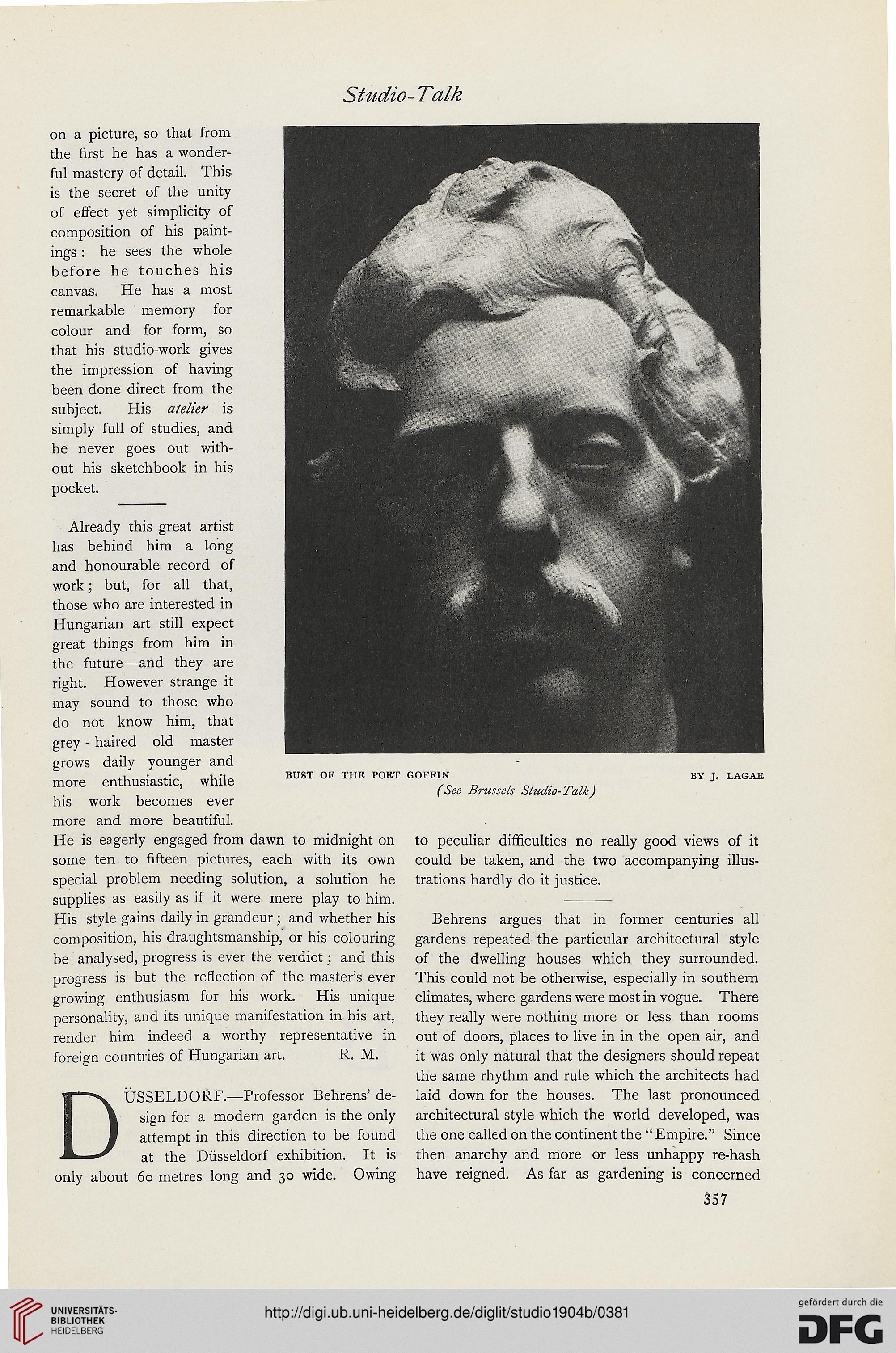Studio- Talk
on a picture, so that from
the first he has a wonder-
ful mastery of detail. This
is the secret of the unity
of effect yet simplicity of
composition of his paint-
ings : he sees the whole
before he touches his
canvas. He has a most
remarkable memory for
colour and for form, so
that his studio-work gives
the impression of having
been done direct from the
subject. His atelier is
simply full of studies, and
he never goes out with-
out his sketchbook in his
pocket.
Already this great artist
has behind him a long
and honourable record of
work; but, for all that,
those who are interested in
Hungarian art still expect
great things from him in
the future—and they are
right. However strange it
may sound to those who
do not know him, that
grey - haired old master
grows daily younger and
more enthusiastic, while BUST 0F THE P0BT G0FFI~ BY J- LAGAE
, . , , (See Brussels Studio- Talk)
his work becomes ever
more and more beautiful.
He is eagerly engaged from dawn to midnight on to peculiar difficulties no really good views of it
some ten to fifteen pictures, each with its own could be taken, and the two accompanying illus-
special problem needing solution, a solution he trations hardly do it justice,
supplies as easily as if it were mere play to him. --
His style gains daily in grandeur; and whether his Behrens argues that in former centuries all
composition, his draughtsmanship, or his colouring gardens repeated the particular architectural style
be analysed, progress is ever the verdict; and this of the dwelling houses which they surrounded,
progress is but the reflection of the master's ever This could not be otherwise, especially in southern
growing enthusiasm for his work. His unique climates, where gardens were most in vogue. There
personality, and its unique manifestation in his art, they really were nothing more or less than rooms
render him indeed a worthy representative in out of doors, places to live in in the open air, and
foreign countries of Hungarian art. R. M. it was only natural that the designers should repeat
the same rhythm and rule which the architects had
DUSSELDORF.—Professor Behrens' de- laid down for the houses. The last pronounced
sign for a modern garden is the only architectural style which the world developed, was
attempt in this direction to be found the one called on the continent the " Empire." Since
at the Diisseldorf exhibition. It is then anarchy and more or less unhappy re-hash
only about 60 metres long and 30 wide. Owing have reigned. As far as gardening is concerned
357
on a picture, so that from
the first he has a wonder-
ful mastery of detail. This
is the secret of the unity
of effect yet simplicity of
composition of his paint-
ings : he sees the whole
before he touches his
canvas. He has a most
remarkable memory for
colour and for form, so
that his studio-work gives
the impression of having
been done direct from the
subject. His atelier is
simply full of studies, and
he never goes out with-
out his sketchbook in his
pocket.
Already this great artist
has behind him a long
and honourable record of
work; but, for all that,
those who are interested in
Hungarian art still expect
great things from him in
the future—and they are
right. However strange it
may sound to those who
do not know him, that
grey - haired old master
grows daily younger and
more enthusiastic, while BUST 0F THE P0BT G0FFI~ BY J- LAGAE
, . , , (See Brussels Studio- Talk)
his work becomes ever
more and more beautiful.
He is eagerly engaged from dawn to midnight on to peculiar difficulties no really good views of it
some ten to fifteen pictures, each with its own could be taken, and the two accompanying illus-
special problem needing solution, a solution he trations hardly do it justice,
supplies as easily as if it were mere play to him. --
His style gains daily in grandeur; and whether his Behrens argues that in former centuries all
composition, his draughtsmanship, or his colouring gardens repeated the particular architectural style
be analysed, progress is ever the verdict; and this of the dwelling houses which they surrounded,
progress is but the reflection of the master's ever This could not be otherwise, especially in southern
growing enthusiasm for his work. His unique climates, where gardens were most in vogue. There
personality, and its unique manifestation in his art, they really were nothing more or less than rooms
render him indeed a worthy representative in out of doors, places to live in in the open air, and
foreign countries of Hungarian art. R. M. it was only natural that the designers should repeat
the same rhythm and rule which the architects had
DUSSELDORF.—Professor Behrens' de- laid down for the houses. The last pronounced
sign for a modern garden is the only architectural style which the world developed, was
attempt in this direction to be found the one called on the continent the " Empire." Since
at the Diisseldorf exhibition. It is then anarchy and more or less unhappy re-hash
only about 60 metres long and 30 wide. Owing have reigned. As far as gardening is concerned
357




